47 Trees
"The tree which moves some to tears of joy is in the eyes of others only a green thing which stands in the way." William Blake
The Cairngorms might be venerated for its mountains and lochs, but what I am most in thrall of here is the forest. Its vast spread. Its diversity. Its silent embrace. In among the trees, I feel time happening all at once: bud burst and blossom here, death and decay there. Hopeful saplings tucked in beside gnarled ancients. New growth sprouting from the trunks of fallen giants.
By pure luck, the cottage we found to rent sits in a clearing in Abernethy Forest, one of the largest remnants of the old Caledonian Pinewood that once spread for more than 15,000 km across the Scottish Highlands.
The oldest residents — the granny pines — are direct descendants of the original Scots pines that colonised Scotland after the last ice age. They stand proud amid the younger generation. But it’s not all conifers. Birch mingles with pine along the forest edge. There are shimmering stands of aspen, the leggy shrubs of juniper and slender rowan.
It’s funny to think of such extensive forest cover — 38km2 of it — as a ‘remnant’. An ocean of trees laps the shores of the pale green fields that encircle us. Trees march up and over Tore Hill, Cairn Rynettin and Carn a’ Chnuic. Trees crowd the shores of Loch Garten and Loch Mallachie.
The forest floor is Kermit-green with the leaves of blaeberry right now. In the boggier places, spikes of cotton grass — furry white heads on stiff green stalks — wave in the wind and there are domed cushions of common haircap moss that you can sink your hands into when the ground gives way beneath your feet.
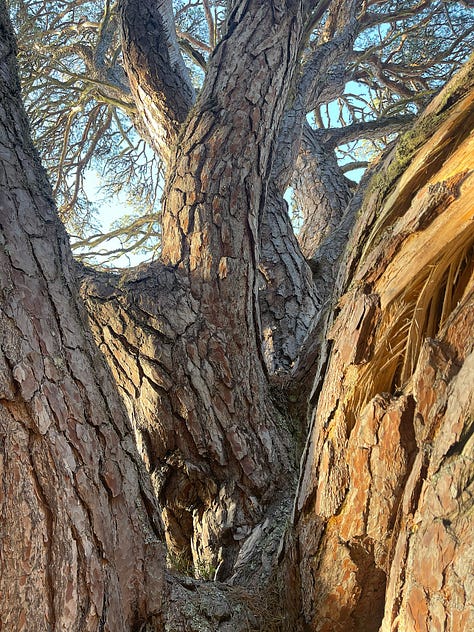
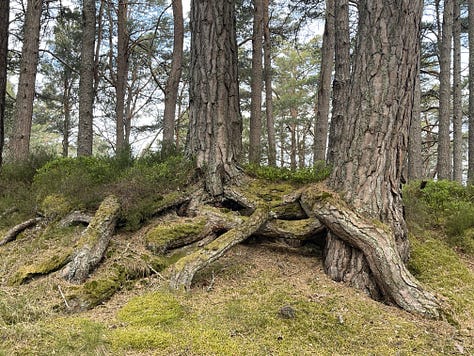
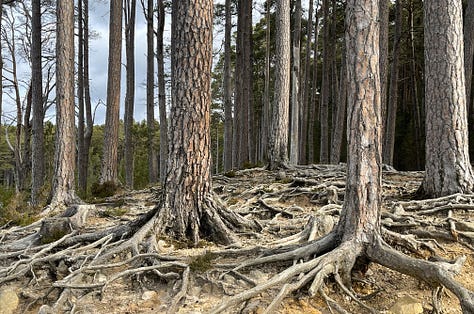
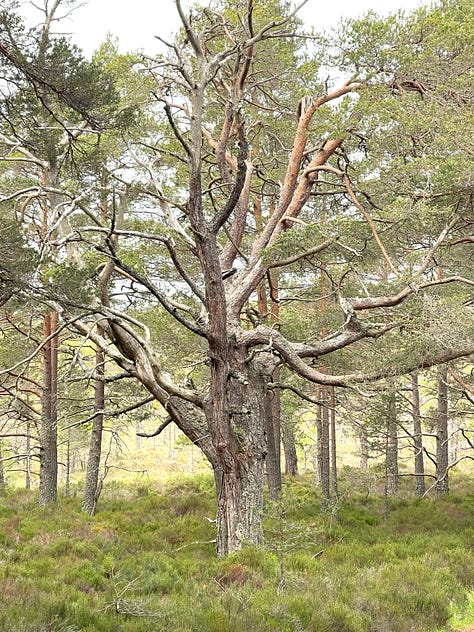

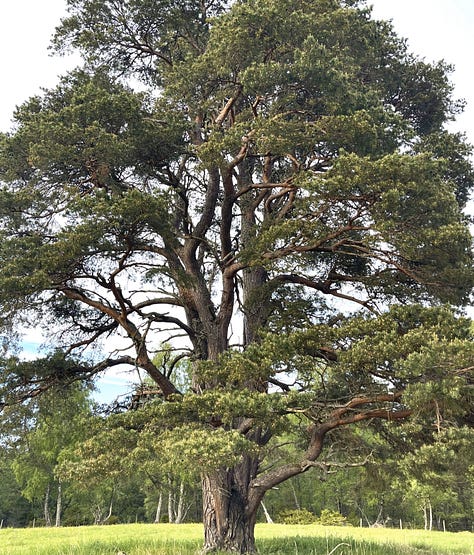
The first time I walked out of my new front door and into the forest, I had a strong feeling of being outnumbered by trees, as if they were crowding around me: ‘Who’s this?’ ‘We haven’t seen you before…’
I found myself thinking there must be more trees than people here, quickly followed by the realisation that yes, of course there are. That’s probably true of the world as a whole. When I got home, I looked it up. The most recent estimate, published in Nature, is that there are 3.04 trillion trees in the world. That equates to 422 trees per person.
Here, it’s easy to accept the reality that we are so comfortably outnumbered. But when you’re walking through a town or city, where, outside of parks, trees tend to be solitary and imprisoned in concrete, it’s easier to imagine that we are the more prolific species.
Of course, the 3.04 trillion trees of the world are not distributed evenly. Tree cover varies wildly from place to place. For example, there are 8,953 trees per person in Canada but not even one each for Saudi Arabians.
In the UK, we don’t fare particularly well. There are just 47 trees for every person. Still… imagine if we all took responsibility for our share — got to know our 47 trees, listened to their needs, looked out for them…
A few years ago, the city of Melbourne in Australia launched its Urban Forest Project with the aim of getting residents to take more care of the city’s trees. The location, genus and age of every tree in the city – more than 70,000 of them – was logged (sorry), given a number and an email address. The idea was that if someone noticed a tree looking poorly, the council could be informed and something done. But it turned into something much more. People wrote emails to the trees, expressing a sense of connection and appreciation, and even sharing memories and secrets.
“Dear Tree, If you are that big, round, beautiful low hanging tree I think you are my favourite tree. Such beauty on such an ugly road,” wrote one admirer to a veteran golden elm.
The scores of mourners who went to pay their respects at Sycamore Gap is another example of the strength of our sense of connection to trees, proof that we can, and do, see them as individuals.
Since I learned about the tree-to-people ratio, I’ve begun to mentally collect my 47 trees.
One of them is the tree by the loch that I wrote about here. Since then, somebody went to that spot, lit an illegal camp fire (fires are not allowed in the Cairngorms National Park because of the high fire risk) and burned some of her roots. I went yesterday, to see how she was faring. There were heather and blaeberry shoots coming up in the blackened ground around her and I didn’t know whether to leave them or nip them out.
Then there’s the tree behind the croft on which I lay down and found a moment of respite from my inner turmoil, and have since returned to many times. There’s also the tree ‘couple’, with their entwined roots, that always make me smile… All the trees pictured above are in Abernethy Forest, within walking distance of home.
But other trees, outwith Abernethy, have taken root in my heart over the years. There’s an oak on Dartmoor that I hold dear, for watching over me the night I first wild-camped solo. And a cottage we often stay in, further south in Perthshire, has this ‘listening tree’ just outside the garden. Try standing next to that lughole without whispering your deepest secrets into it…
The first tree that made an impression on me was a huge Monterey Pine that dwarfed the tea garden at Watersmeet in the Lyn Valley, North Devon. I first saw it on a family holiday in 1976 as a young child and sat beneath its shady canopy on many subsequent visits. But by the time I moved to the Lyn Valley in 2001, it had been chopped down. I was glad to find this photograph, that shows I hadn’t misremembered its majesty…
I made friends with many local trees when I lived in East Sussex, too. Oaks with full, round crowns, a twisted-trunked sweet chestnut resting branches on the ground for extra support, and a willow that leaned out across the River Rother, trailing fronds in the water that I could paddle beneath in my kayak.
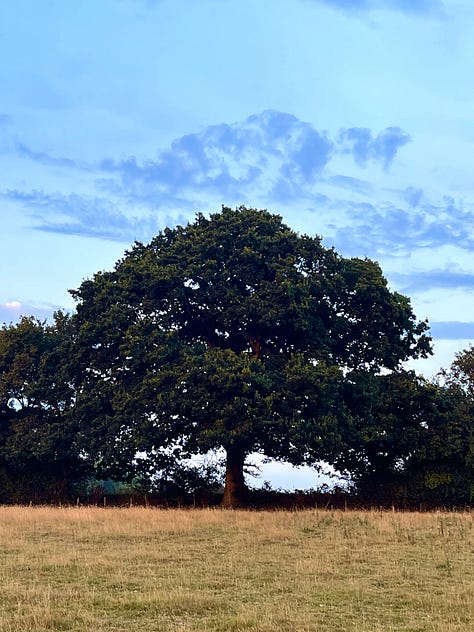
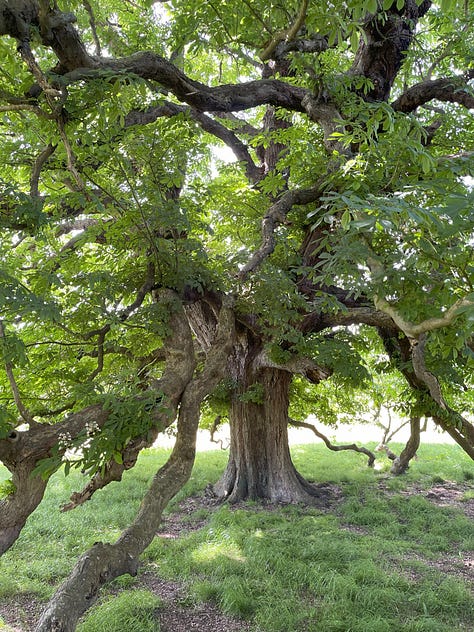
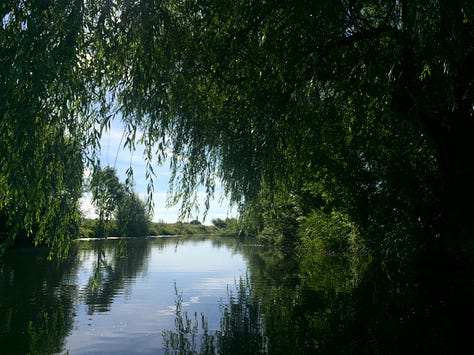
There was one huge oak tree that stood at the meeting point of four fields, through which I walked almost every day. Long dead, yet full of life. Jackdaws nested in one of its high cavities and it was a favoured spot for the drum rolls of great spotted woodpeckers.
But one evening, the space yawned empty. It took me a moment to comprehend what was missing. The tree had been felled; severed branches lay in the sawdust around the stump of its vast trunk — like limbs on a battle field.
“I’m going to hold a ceremony for the felled oak tree,” I told my husband. I gathered petals from the flowers in my garden and we trudged across the fields together. I laid my hands on the rough surface of the stump, apologised for its felling and thanked it for its long life. Then I scattered the petals and took a branch to add to my dead hedge. Jeff and the dog looked the other way. Did I feel foolish? A little, yet somehow sure that my actions were needed – that they would be received and understood. Yes, it was just one tree, but could it not stand in for the swathes of forests that are going, or already gone?
While 3.04 trillion is a big number, it’s estimated that around 12,000 years ago — before homo sapiens began making our mark on the planet — the number of trees was twice as high. I once attended a talk that Peter Wohlleben, forester and author of The Hidden Lives of Trees, was giving. Someone asked him what he thought trees would say to us, if they could talk. He paused for a moment, and then he said: “They would warn us to be more gentle.”





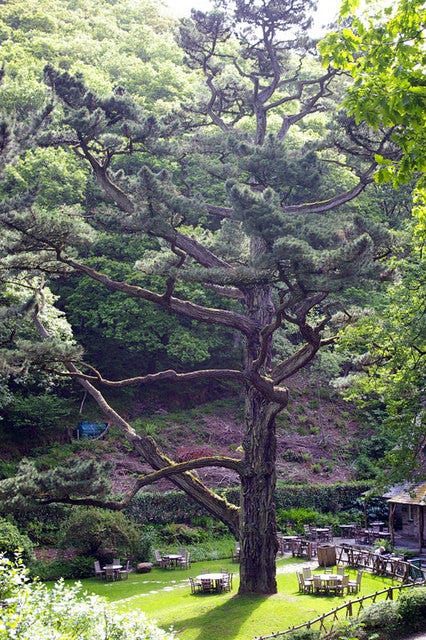
Another beautiful post Sam, I love your writing so much. And I also love trees and am now mentally compiling my 47! I still squeal with child-like delight at 'square trees' where branches grow at right angles to accommodate busses and lorries.
I'm lucky to live opposite a Victorian park with many wonderful trees - although my local council has quite an aggressive (in my opinion), tree management policy which has involved us losing some of my favourites. I purposefully went and spent a few minutes with each tree that had a notice on it, to say thank you (and sorry) and I didn't feel in the slightest bit silly. It just seemed the right thing to do.
This welled me up, Sam. So beautiful. Thank you 🥹